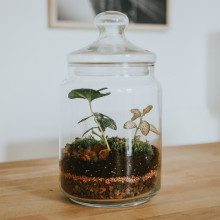Can frogs survive in a sealed terrarium?
Listener Jon sent us this question: "I just purchased some dart frogs which need to live in high humidity conditions. In order to attain this we basically sealed off the terrariums. The question is whether a really sealed terrarium could provide enough oxygen for the frogs through plant photosynthesis alone. Who would win: the frogs or the plants?" Phil Sansom got the answer to this 'pet peeve' from plant scientist Stephanie Smith...
In this episode

QotW: Can frogs live in terrariums?
Phil Sansom has been croaking out an answer to this question from Jon...
Phil - So Jon has got his pet frogs living in a tank with some earth, plants, and moss. It sounds like he left some holes in there, thank god, but what would happen oxygen-wise if he shut them in for good? Here’s plant scientist Stephanie Smith.
Stephanie - There’s two processes involved in this question: photosynthesis and respiration. Photosynthesis uses carbon dioxide and water, and in a reaction powered by light energy, produces glucose for plants – and it produces oxygen as a by-product.
Phil - And then the other process, respiration, is sort of the opposite. It’s the one both plants and animals use to get their energy. It takes sugar in - that’s glucose - which combines with oxygen, and it makes energy, plus some carbon dioxide and water on the side.
Stephanie - You might have noticed that the by-products of respiration are the starting ingredients for photosynthesis, so can the plants just run the two processes in perfect balance? To some degree, yes! In 1960, a reverend called David Latimer placed a spiderwort plant in a huge sealed bottle garden. It has survived unopened since then. So we know plants survive pretty well in sealed tanks. But what would happen if you introduced an animal?
Phil - Both the plants and frogs would be using oxygen for respiration, but the plant would also be producing extra oxygen from photosynthesis. Leaving aside the question of frog food, we want to know - in the words of listener Jon "who would win, the frogs or the plants?"
Stephanie - It would depend on the size of the tank and the number of plants – after all, the earth itself is a similar system on a huge scale! The practical answer is more complex. Researchers in Arizona built a facility called ‘Biosphere2’ to see if eight humans could survive in a sealed system for two years. The oxygen levels fluctuated wildly, and extra oxygen had to be injected into the system to keep the people alive.
Phil - Biosphere 2 ran two such experiments in the nineties, and they ultimately ended in a bizarre story of sabotage and takeover by the now far-right US news mogul Steve Bannon. But that’s another story, and regardless: if the oxygen fluctuates wildly in the Biosphere 2, which is a 3-acre compound, it certainly does in terrariums that are about half a metre across.
Stephanie - It drops a lot at night when there is no light to power photosynthesis. Although certain small insects can deal with these oxygen fluctuations well, most animals cannot.
Phil - So Jon, there you go: either make sure your sealed terrarium is an acre or so wides, or stick to your ones with holes in the sides. Thanks for that question. And next week’s is ‘special delivery’ from Pavel..
Pavel - On one of the Naked Scientists programmes it was mentioned that a newborn baby has initially sterile intestines and gets most of its microbiome during the passage through the uterus and vagina. What happens to children that are brought into this world via caesarean?









Comments
Add a comment